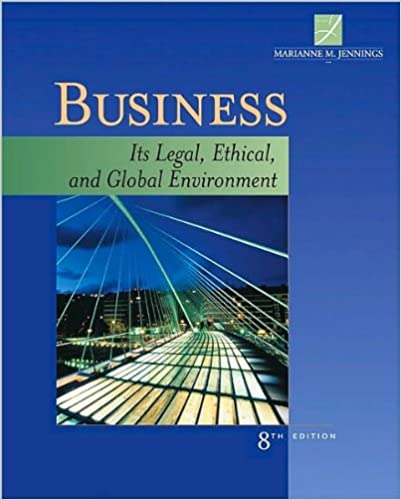
Business 8th Edition by Marianne Jennings
Edition 8ISBN: 978-1285428710
Business 8th Edition by Marianne Jennings
Edition 8ISBN: 978-1285428710 Exercise 28
If s a Wonderful Life, but Whose Is It? Using Property Rights to Preserve Earnings
In 1946, director Frank Capra produced It's a Wonderful Life, a movie based on a short story by Philip Van Doren Stern called "The Greatest Gift" The movie, starring Jimmy Stewart, did not perform well at the box office, and, although it received five Academy Award nominations, it won no awards. The movie's copyright was allowed to lapse. Television stations showed the classic without paying fees since the copyright had lapsed.
However, the U.S. Supreme Court decision in Stewart v Abend, 495 U.S. 207 (1990), offering an extension of the copyright protection of the underlying story to the movie, affected Jimmy Stewart's life once again. The original story owner, Mr. Stern, had the rights to the story since the movie rights had lapsed. With his story copyright in place, royalties for its use in the movie had to be paid once again. The owners of It's a Wonderful Life began charging fees to cover their fees to Mr. Stern, and the result was costly access. It's a Wonderful Life was seen on television day and night during the holiday season when the copyright on the movie had lapsed. Now, with the copyright clarification, the movie rights have been reprotected. The story's continuing protection and the high royalty fees make It's a Wonderful Life a singular holiday event.
What is the relationship between movie copyrights and the rights to the underlying story? Who owns what between story authors and movie producers? What should businesses negotiating movie rights and royalties be certain about before signing an agreement?
In 1946, director Frank Capra produced It's a Wonderful Life, a movie based on a short story by Philip Van Doren Stern called "The Greatest Gift" The movie, starring Jimmy Stewart, did not perform well at the box office, and, although it received five Academy Award nominations, it won no awards. The movie's copyright was allowed to lapse. Television stations showed the classic without paying fees since the copyright had lapsed.
However, the U.S. Supreme Court decision in Stewart v Abend, 495 U.S. 207 (1990), offering an extension of the copyright protection of the underlying story to the movie, affected Jimmy Stewart's life once again. The original story owner, Mr. Stern, had the rights to the story since the movie rights had lapsed. With his story copyright in place, royalties for its use in the movie had to be paid once again. The owners of It's a Wonderful Life began charging fees to cover their fees to Mr. Stern, and the result was costly access. It's a Wonderful Life was seen on television day and night during the holiday season when the copyright on the movie had lapsed. Now, with the copyright clarification, the movie rights have been reprotected. The story's continuing protection and the high royalty fees make It's a Wonderful Life a singular holiday event.
What is the relationship between movie copyrights and the rights to the underlying story? Who owns what between story authors and movie producers? What should businesses negotiating movie rights and royalties be certain about before signing an agreement?
Explanation
It is a Wonderful Life was a movie direc...
Business 8th Edition by Marianne Jennings
Why don’t you like this exercise?
Other Minimum 8 character and maximum 255 character
Character 255


